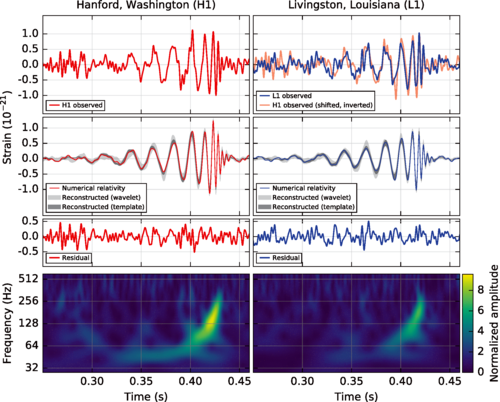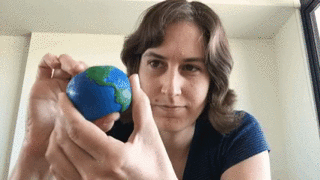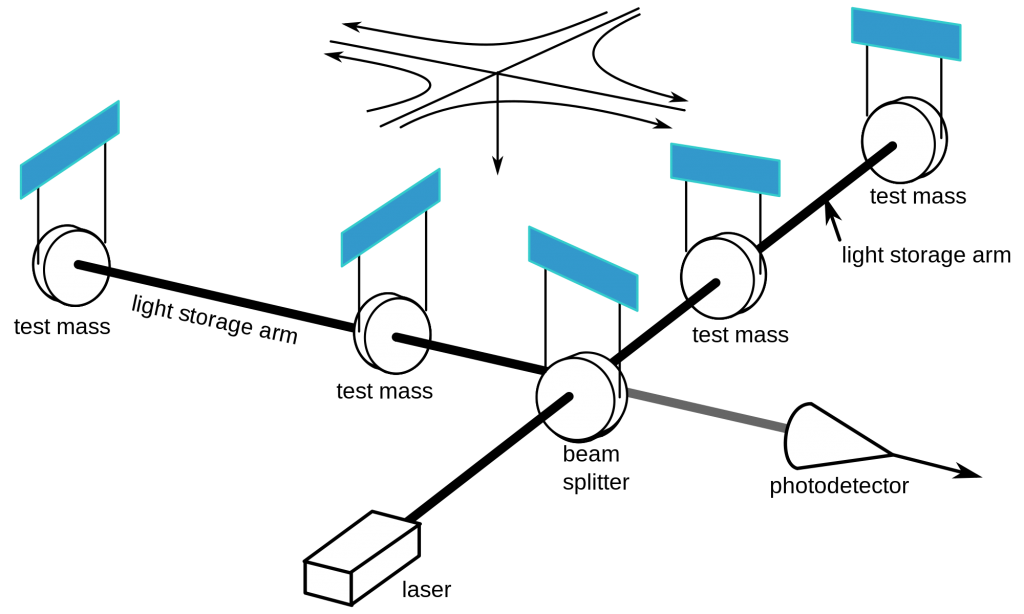By Stephanne Taylor, Physics & Astronomy Editor
Just over two weeks ago, physicists at the Laser Interferometer Gravitational-Wave Observatory, or LIGO, announced that they had, for the first time, directly observed a gravitational wave, dubbed GW150914. The physics community promptly exploded in giddy excitement.
The first directly detected gravitational wave. Figure 1 from Observation of Gravitational Waves from a Binary Black Hole Merger, by B.P. Abbott et al. (LIGO Scientific Collaboration and VIRGO Collaboration). Physical Review Letters, 116, 061102. doi: http://dx.doi.org/10.1103/PhysRevLett.116.061102
Physicists are so excited about this announcement because directly observing gravitational waves opens up a whole new window on the universe. Until now, physicists and astronomers relied on light and particles to observe the universe, but gravitational waves provide information about structures that traditional astronomy has difficulty describing, like black holes and neutron stars.
Schematic of the inspiral of two black holes. The two black holes’ orbits become increasingly tight, until the two black holes merge, and the resulting, larger black hole rings down. Gravitational waves are emitted throughout this process, but are shown only during ringdown.
Gravitational waves are the response of the fabric of the universe to the motion of mass: as mass accelerates through the universe, the shape of space and time curves around it, and waves propagate away from the mass. This response is mind-bogglingly weak, which is why we don’t experience the universe noticeably oscillating when we turn a corner or run for the bus. But when an enormous amount of mass accelerates very quickly (as in a pair of black holes spiraling in on themselves and merging), the gravitational waves generated have a minuscule, but detectable, amplitude. Matter in the path of a gravitational wave will be alternately stretched and squished:
Gravitational wave alternately stretch and squish the earth (here, greatly exaggerated for effect). Gif courtesy of Dr. Katie Mack.
To detect such minute fluctuations, you need a very large, extremely carefully calibrated instrument. LIGO consists of two L-shaped vacuum chambers, one in Livingston, Louisiana and the other in Hanford, Washington. Each arm of the detector is four kilometres long, and has a mirror close to the corner and another at the end of the arm. A carefully calibrated laser beam is split at the corner of the L, and laser light shines down each of the two arms.
A schematic of the LIGO interferometers. Light from the laser is split, travels down each arm, and is recombined at the photodetector. Courtesy of the LIGO Collaboration.
This light passes through the mirror closest to the corner and continues to the end of the arm, where it is reflected back to the first mirror. The light reflects back and forth in the arm, effectively increasing the arm’s length. The light eventually passes through the mirror close to the corner and combines with light from the other arm. If the two arm lengths are identical, the light waves cancel each other out and no light is detected. However, if the arms are of very slightly different length as a result of a gravitational wave stretching and squeezing them — even just a fraction of the width of a proton! — the interference pattern changes, and light is gathered by the detector.
The interference pattern of this light indicates the changes in the arm length, and thus the form of the gravitational wave. A gravitational wave detected at one facility should be detected at the other within a few milliseconds, and the difference in time between the two detected signals defines the region of sky from which the gravitational wave arrived. Because gravitational waves are very weak, the detector is extremely sensitive to its environment. The LIGO detectors are seismically isolated, and the interferometer has been designed to minimize environmental noise in the system.
“The GW150914 signal is the first evidence of the existence of a black hole binary inspiraling and merging…”
As well as literally providing a new way to explore the universe (and starting the era of gravitational wave astronomy), the LIGO papers released so far have some other tantalizing results. The GW150914 signal is the first evidence of the existence of a black hole binary inspiraling and merging, which has substantial implications for astrophysics and confirms decades of theoretical and modelling research.
The black holes involved in the binary merger were heavier than those detected using other astronomical methods, indicating that heavy black holes exist. The structure of the waveform was analyzed specifically to test for possible violations of general relativity in a strong-gravity environment, and none were found. Additionally, the detected wave has placed a stronger limit on the mass of the graviton, which is to gravity what the photon is to light, and is as yet undetected. The GW150914 signal indicates that the graviton cannot have a mass larger than 2.16×10−58 kg.
” It may be difficult…for Canadian researchers to participate in the future of gravitational wave astronomy..”
LIGO is a massive collaboration, with contributions from researchers around the world, but the only Canadian contributors are a handful of researchers at the Canadian Institute for Theoretical Astrophysics (CITA). Dr. Harald Pfeiffer, Dr. Prayush Kumar, Heather Fong, and Dr. Kipp Cannon contributed theoretical waveforms that were used to verify that the observed signal was the result of the collapse of a black hole binary.
Gravitational physics is not a (general) relatively large field, and there are very few physicists in Canada working specifically on gravitational waves. Those who do are scattered across institutions, and many focus primarily on related areas of gravitational physics rather than on gravitational waves. A quick scan of the research groups in the major physics departments and institutions across Canada shows that only CITA explicitly listed “gravitational waves” as a major research area. It may be difficult, then, for Canadian researchers to participate in the future of gravitational wave astronomy, if there are few research groups available to participate in any gravitational wave observatory collaborations. However, gravitational wave observations may be combined with traditional astronomical observations, and Canadian researchers may be able to contribute in cross-disciplinary projects.
There are already new and more sophisticated gravitational wave detectors planned for construction. LIGO-India, or INDIGO, received in-principle approval from the Indian government last week. The VIRGO Interferometer, whose researchers collaborated with the LIGO group in the recent discovery, is being upgraded and will be back online later this year. There are also plans to build an interferometer in Japan, and space-based detectors like the European Evolved Laser Interferometer Space Antenna (eLISA) and the Chinese TianQin have also been proposed. The LISA Pathfinder probe was launched last December, and is currently testing some systems necessary for the eLISA mission.
Having more detectors online will not only increase the likelihood of detecting gravitational waves, but will make it easier to determine their points of origin through more precise triangulation. This will allow gravitational wave astronomers to more easily collaborate with light and particle astronomers in looking for the event which caused the waves. With more detectors coming online, and plenty of excitement around this landmark observation, the future of gravitational wave astronomy is bright.








